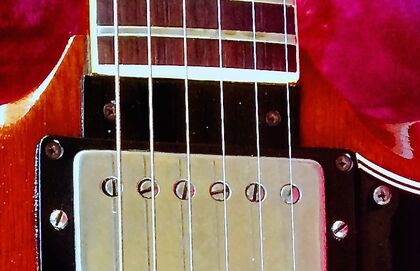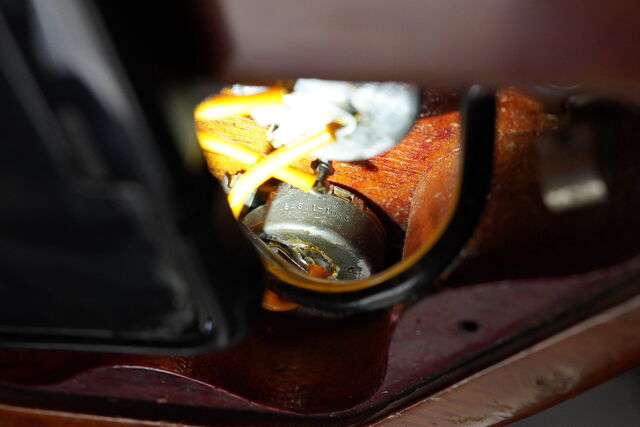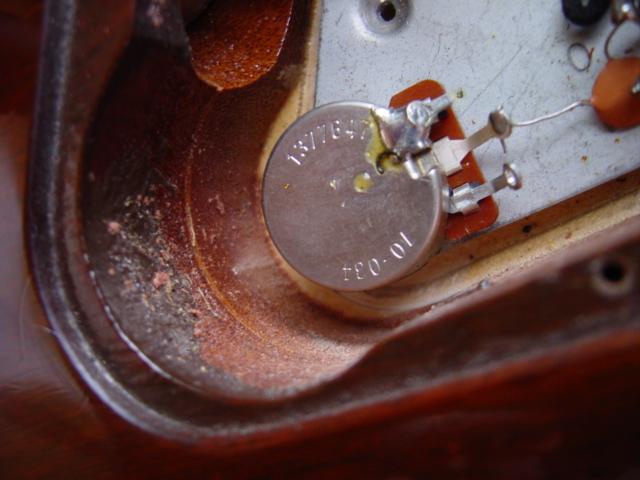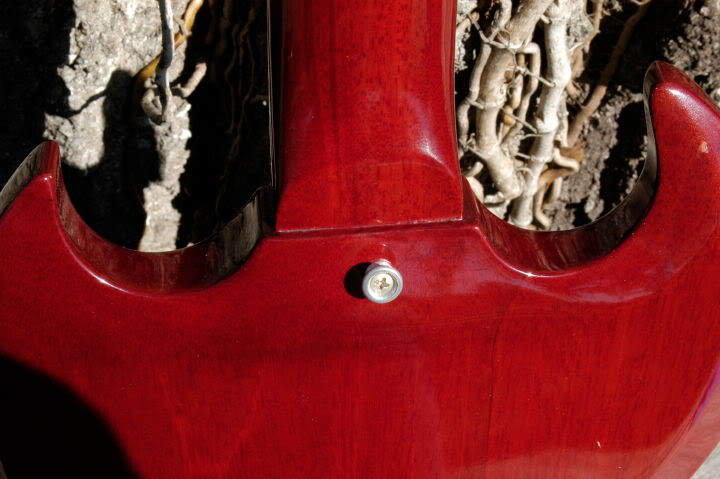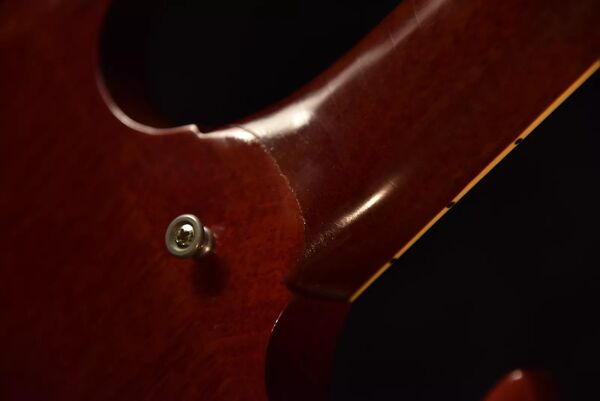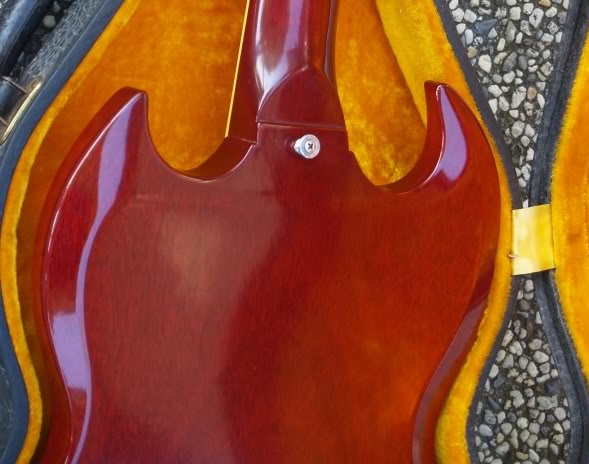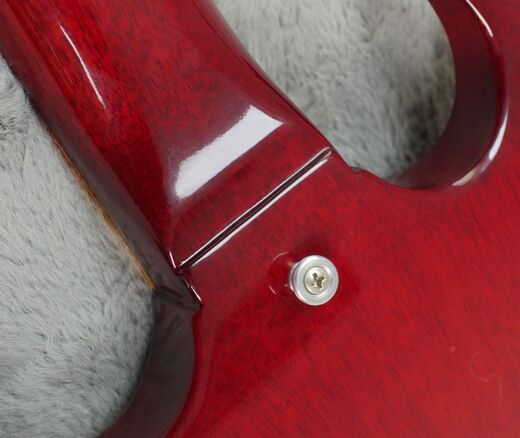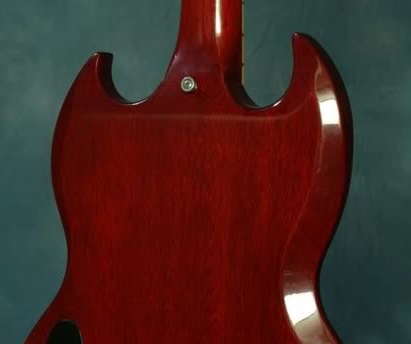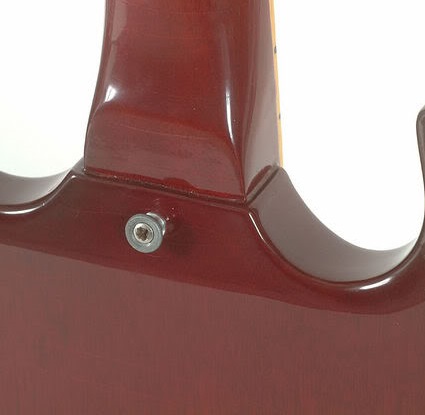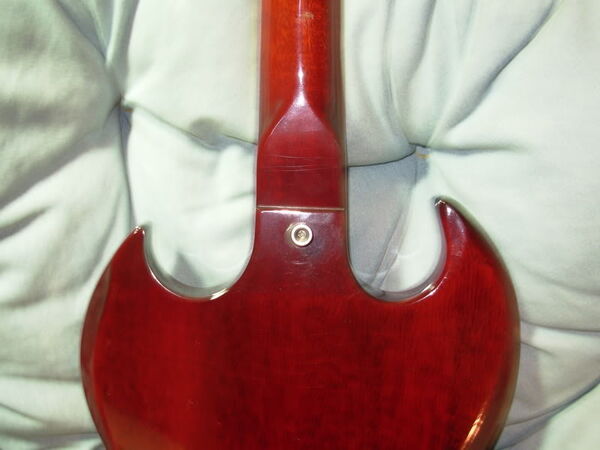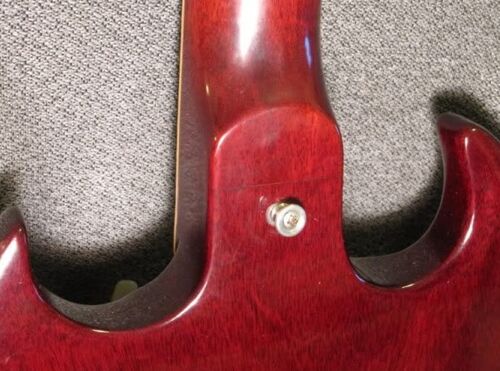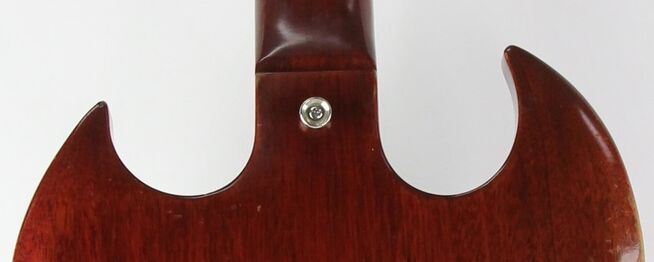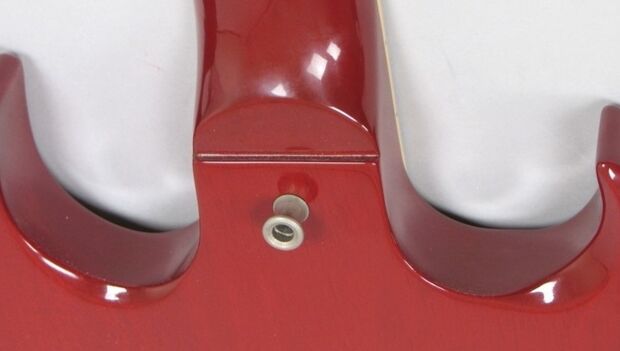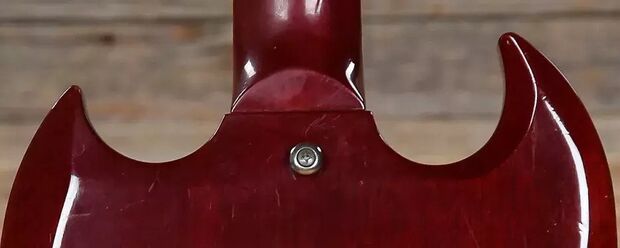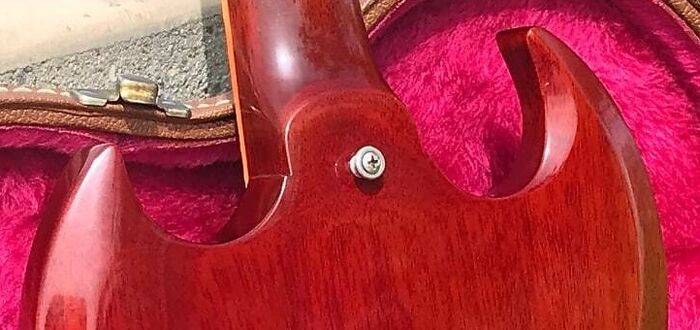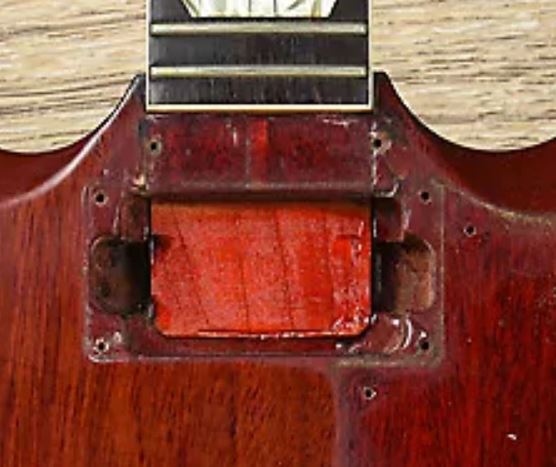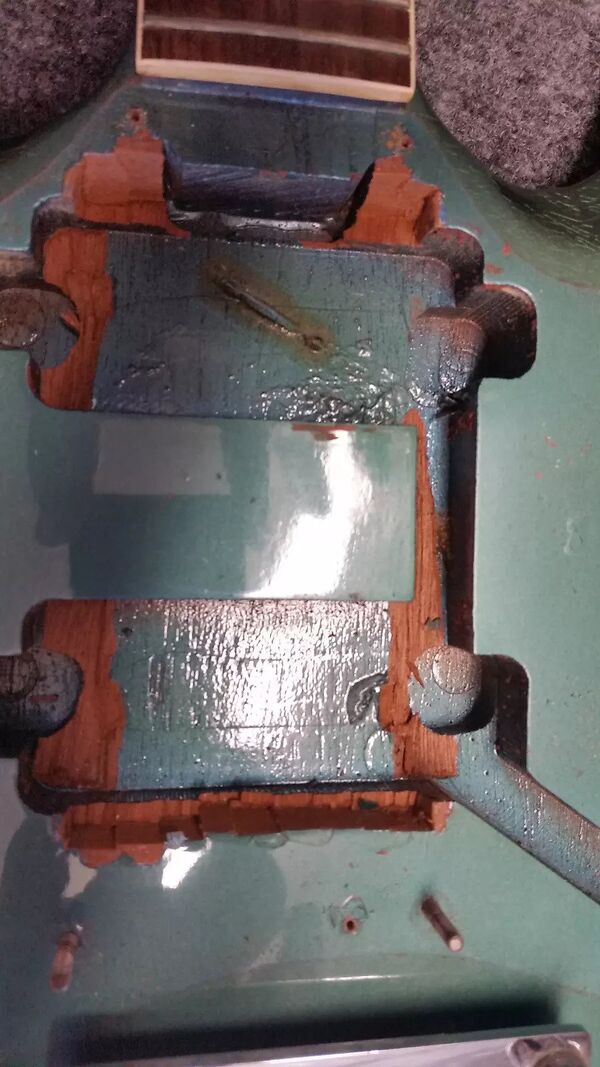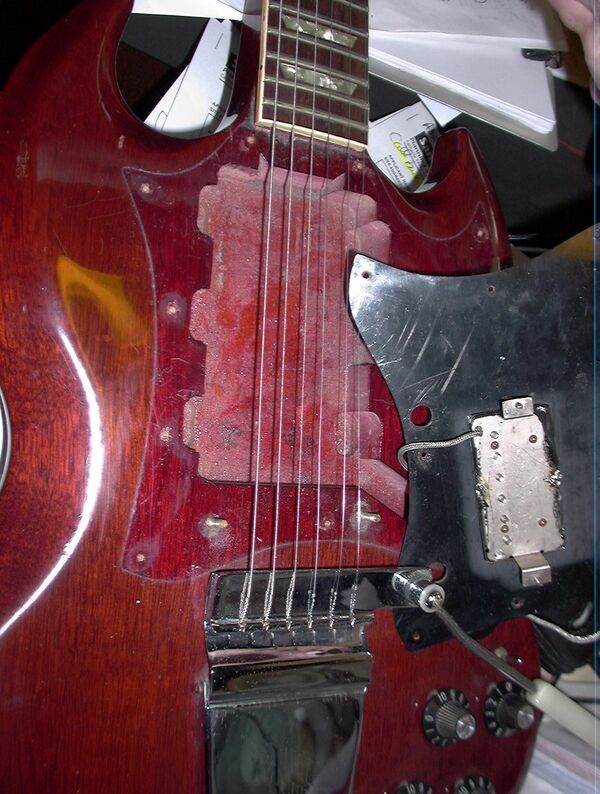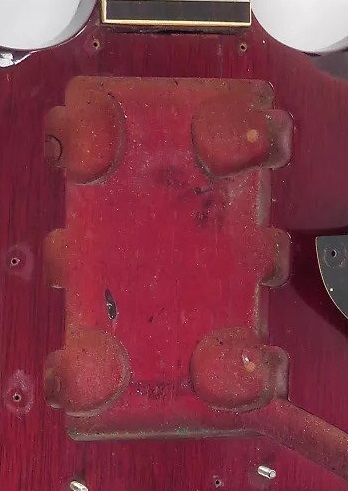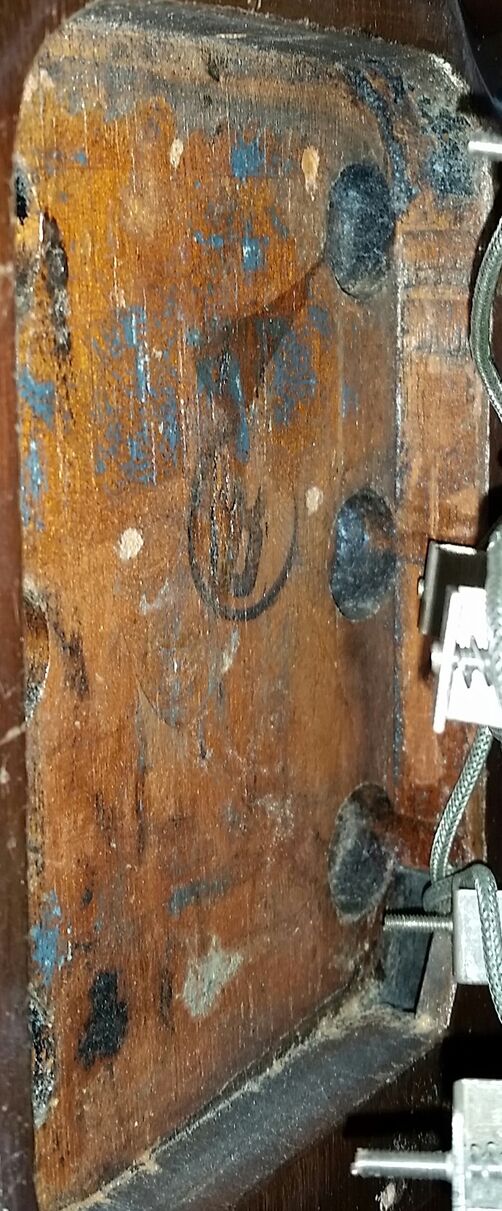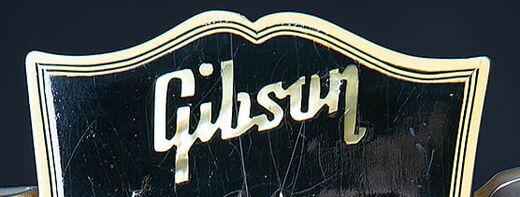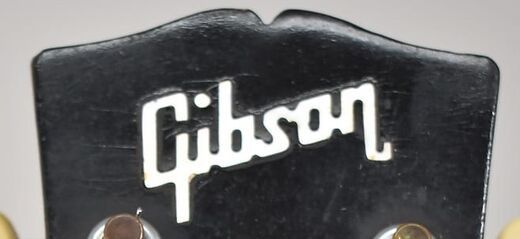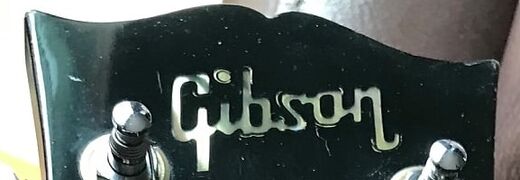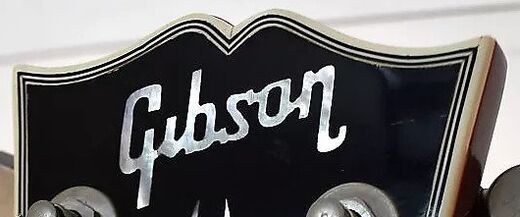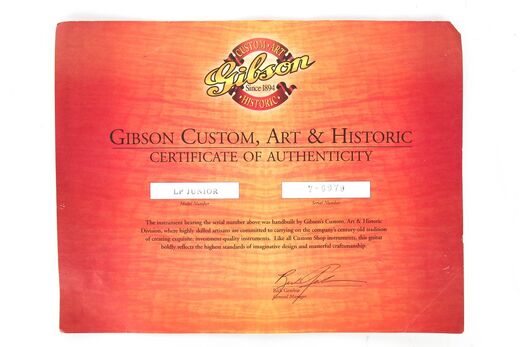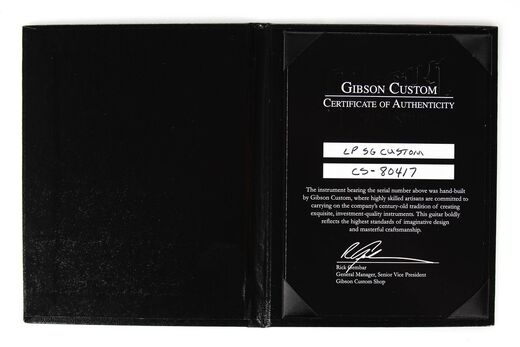The first step in dating your Gibson SG is buying it a nice bouquet of flowers...
Seriously though, the best way to date a vintage SG is often not the serial number, but rather by the potentiometer codes and other features it has. Only in 1977 did Gibson switch to a reliable serial number system which can be trusted as a dating tool. Even then, you want to have a rough idea of when it was made based on the features first, because they have used several different serial number formats through the years.
It is important to remember that no one feature is the absolute determinant factor in dating, but rather the totality of all features taken into consideration.
Note to vintage buyers: The "Fretless Wonder" term referred only to SG Customs made from 1961–1975. It is not normal for any other vintage SG to have remarkably low frets. If this is the case, the guitar needs a re-fret. Beware sellers passing off worn out frets as a "Fretless Wonder"
Potentiometer Codes[]
The code on the back or side of a potentiometer can normally be broken down into three main components: the manufacturer, the year and the week of manufacture. However, it is important to remember that this date is when the pot was made, which necessarily has to be before the guitar was made. Being produced in large batches, it can be a while before every pot in a batch is installed on a guitar. Generally assume 5–8 weeks between production and installation on a guitar. However, they can also sometimes take a year or longer to be used. In fact, it's not uncommon to find an SG with pots dated several years before it was actually made based on the other features. Most commonly, this seems to occur on 1967 models with pots dating to 1965. It is possible that a batch of forgotten pots from 1965 were discovered that year, but the reason is anyone's guess. Ultimately, it's important to remember that no single feature is the absolute determinant factor in dating, but rather the totality of all features taken into consideration.
Centralab:[]
1961—mid 1963
Centralab pots have their code on the side of the pots, making it more difficult to read than CTS. The code in question will be the topmost string, closest to the guitar's body. The pot pictured below reads: "1346103". This means the pots were made by Centralab (134) in 1961 (61) in the third week of the year (03). This means the guitar was most likely shipped out in the spring of 1961.
CTS:[]
Mid 1963—Present
The pot pictured below reads: "1377647". This means the pots were made by CTS (137) in 1976 (76) in the third week of November (47). This means the guitar was most likely shipped out in early 1977.
Heel Joints[]
One of the ways to date a 1960s SG in particular, is by the design of the heel. This is because the heel is an integral part of the body construction and bodies are used immediately and not set aside to wait, whereas parts like potentiometers are dated by the manufacturer before being shipped to Gibson and waiting to be installed, as the large batch is used up over time. Gibson redesigned the heel multiple times throughout this decade, although sometimes previous heel designs would re-appear. By the 1970s, heel joints became more standardized.
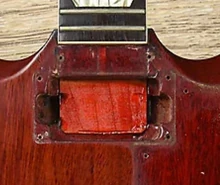
Editorial Note on the SG's "Flimsy Heel": The idea that most vintage SGs have at some point had their neck broken is essentially a myth. Headstock breaks are more common, but that still doesn't mean the design is somehow flawed. Simply put, fine instruments are often delicate and are to be treated with care. You wouldn't call a Stradivarius violin "flimsy". Generally speaking, SGs were not treated with care until they started gaining vintage status in the 1990s, much later than the Les Paul. Also, people seem to assume the early '60s design is weak simply because of how it looks from the outside, without knowing the design of the mortise and tenon. The design featured a substantial tenon spanning the entire width of the neck, which reached nearly to the back of the neck pickup cavity as well. Meanwhile, modern Custom/Historic SGs use a functionally identical design and have not gained a reputation for neck breaks. Also, it's not like there aren't late '60s SGs or even Les Pauls with broken necks; no guitar is immune from breaking if dropped or otherwise mishandled. Guitars are not designed to withstand impacts; they aren't crash-tested like automobiles.
The original design found on late 1960 through early 1961 builds:
From mid 1961 through early / mid 1962, the body overlapped the neck and the transition was smooth:
From early / mid 1962 through the end of 1962, the flat area returned and the hangover stepped down:
For 1963, the flat area became smaller and the use of a hangover seems random. It stayed like this through 1965, with some variation due to hand-shaping.
Also in 1963, some can be found with completely smooth hangovers:
In early / mid 1965, the hangover was largely removed (though some examples retained it):
And in early 1966 (before the switch to the batwing pickguard), the design made a radical change to the style that would remain through 1968 and into early 1969:
In early / mid 1969, it changed to this style:
Late in 1969, the step returned:
And in mid 1970, the flat area on the neck was reduced in size:
This heel design remained unchanged throughout the 1970s and even into 1980.
In 1981, the flat area on the neck increased in size slightly:
And in 1984, it became more rounded:
In 1986, with the introduction of the SG-62, came a divergence in heel design. The Standard and Special retained the previous design while the SG-62 got a new design, clearly based on the late 1960 - early 1961 style:
This dichotomy continued until 2013, when the '61 Reissue was discontinued and the Standard was redesigned with the Reissue's heel design. From 2016 onward, the Standard has returned to it's original 1984-2012 heel design and in 2019, the Standard '61 was introduced to take the place of the '61 Reissue, as well as its heel design.
In 2000, the Custom Shop Historic Reissues were introduced adding yet a third heel design to the SG lineup. This incorporates a smooth hangover:
However, some (seemingly at random) have a stepped heel, which has become more common in recent years:
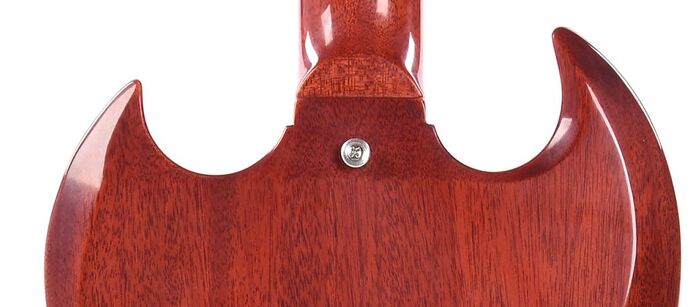
Pickup Routing[]
Another feature that would change through the 1960s was the style of pickup routing. Note that this guide refers only to the SG Standard.
The first style was the same routs seen on Les Pauls:
That would be used until the switch to the Batwing pickguard in early–mid 1966.
Then, came a slightly different style with wiring channels (mostly) routed as well:
Note that the unpainted extensions to the far ends of the routs in the above picture are aftermarket work.
Also note the change in tenon design, as the heel was also redesigned in early 1966.
The next style, introduced in late 1966 or early 1967, is known as the "Swimming Pool" rout. This simplified construction so that the Standard and Custom would use the same rout. However, Specials and Juniors still used a different rout to accommodate the longer P-90 pickups.
In early 1969, the design changed slightly, with no visible neck tenon:
In late 1970, it changed yet again to a simple rectangle shape with more rounded corners and circular routs for the pickup legs:
And around mid 1971, it changed again before the lineup was redesigned later in the year. This time, it went back to the individual routes, now shaped to accommodate many different pickup types:
Gibson Logo Font[]
1961-1969[]
Throughout the 1960s, the Gibson logo's font remained the same classic style they had used since 1947:
Note: changes from here on-out only apply to inlaid mother of pearl logos. Silk-screened logos remain unchanged from 1947 to present day.
In 1969, all inlaid mother of pearl logos lacked a dot over the "i".
Important Note: it is not uncommon for the dot over the "i" to be missing from almost any year. It is only notable that in 1969, it was consistently missing. Therefore, a missing dot is not conclusive proof of a 1969 build, but having a dotted "i" would generally rule out the year 1969.
This logo was still used into early 1970.
1970-1972[]
In early 1970, a new font style appeared, which was thicker with more squared edges. Shortly after the font changed, the openings in the "b" and "o" were closed:
This style can still be found sporadically through 1973.
1971-1976[]
In 1971, another change is made (only for SG Customs until 1973), this time going back to a style closer to the '60s logo with more rounded characters, but retaining the closed "b" and "o". This logo is most easily identified by the bulges at the ends of the "s":
Generally, this logo is thinner than the previous (particularly the "s"), but can also be thicker in some cases:
This logo returns sporadically in 1979/1980. It returns again sporadically in 1988, but with the "O" connected to the "N" at the top, instead of the bottom. That style was used on Les Pauls frequently post-1981, but the SG kept the old logo, with this small exception.
1975-1989[]
The squared logo from 1970-1972 returns unchanged, at first sporadically in 1975 and 1976, becoming consistent in 1977 as the previous logo is phased out.
1986-Present[]
The classic '60s logo first returns on the SG-62 in 1986 (and the Custom, now based on the SG-62), although its use is not consistent. Many SG-62s use the old logo. By 1988, the classic logo becomes more consistent.
The SG Standard does not start to get the classic logo until 1988, and still sporadically gets the old logo until as late as 1992.
Other Changes[]
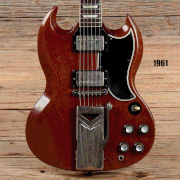
Despite the common misconception (and being stated in John Bulli's book), the body shape of the SG was not changed in the 1970s. The bass side horn was very slightly longer, but the only significant change was in beveling. The only SG to ever have a redesigned body shape was the 1986-1991 SG-62. See the image to the right for a comparison of body shape over the years.
1960–1979[]
Note: most of these changes were slowly phased in as the old parts were used up, so these are just general guidelines.
Also, to keep things simple, these changes do not necessarily apply to the Melody Maker and its descendants, although some may.
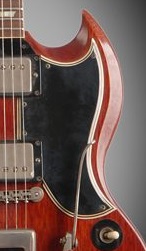
Longer 1960 pickguard
Late 1960:
- Sideways vibrola (Standard/Custom)
- Longer pickguard (Standard/Custom)
- Reaches down to switch
- Sharper, longer points
- No screw under bridge pickup
- Variation in tenon cover design (Standard/Custom)
- Blank truss rod cover
- "Les Paul" script silk-screen on headstock (Junior)
- Ink-stamped serial with '50s format
- Brown Lifton style case w/ pink lining
1961:
- Smaller tenon cover (Standard/Custom)
- "Les Paul" engraved truss rod cover (Standard/Custom)
- Shorter pickguard (Standard/Custom)
- Impressed serial with new format
- Note: Dark grain filler can make this appear ink-stamped
- Black case w/ gold lining
1962:
- Ebony block vibrola (Standard/Custom)
- Nylon bridge saddles & retaining wire introduced on ABR-1 (Standard/Custom)
- Optional short vibrola (Junior/Special)
1963:
- Kluson "Waffleback" tuning machines (Custom)
- Compensated wraparound bridge/tailpiece (Junior/Special)
Mid-1963:
- All "Les Paul" script instances removed
- Maestro vibrola (Standard/Custom)
- Switch to CTS pots
Late 1964:
- Double line Kluson tuners (Standard)
1965:
- Indian Rosewood fretboard
- Standard bevel truss rod cover (Special/Standard/Custom)
- 14 degree headstock pitch
- This decreases downward pressure on the nut (compared to the previous 17 degrees), resulting in less sustain, but easier bends and less binding.
- Short vibrola becomes standard (Junior)
- 1 9/16" nut width by end of year
Mid 1965:
- Chrome hardware (Standard/Special/Junior)
- Larger control cavity route
- Full-size route now used on Junior
Early 1966:
- New heel design
Early / Mid 1966:
- "Batwing" pickguard
Mid / Late 1966:
- Crown inlay positioned lower (Standard)
- Previously, the bottom was in line with the middle tuners, now the entire inlay is centered
- "Swimming Pool" pickup route (Custom/Standard)
- "Batwing" pickguard (Junior)
Mid 1967:
- "Witch Hat" knobs
- Medium bevel pickguard
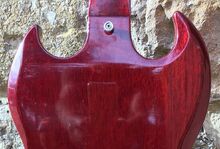
Angled heel (1961 - early 1969)
Early 1969:
- No dot over "i" in "Gibson" logo
- New crown inlay w/ shorter top half (Standard)
Early / Mid 1969:
- Walnut finish option
- 3-pc laminated neck
- Small bevel pickguard
- "Gibson Deluxe" tuners (Standard)
- Still made by Kluson, only name changed
- Narrower headstock
- Non-angled heel
- 24 9/16" scale length
- While a very slight change of 1/16", this reduction in scale length would result in lower string tension.
Late 1969:
- Small volute begins to appear
1970:
- Volute
- This is a feature used on violins to strengthen the naturally weak spot where the neck meets the headstock. It was introduced gradually, "growing" throughout the year to its full size.
Mid 1970:
- New "Gibson" logo (Mother of Pearl inlays only)
- Closed "b" & "o"
- Dot over "i" returns (except on Junior)
- More squared font style
- Resin impregnated fiberboard headstock veneer (Special/Standard/Custom)
Mid / Late 1970:
- "Made in U.S.A." stamp
1971:
- Natural finish option
- Individual pickup routes (Custom/Standard)
Late 1971 Redesign:
- Control cavity moved to front of body
- Les Paul pickguard
- Headstock less tapered in width
- Neck meets body at 20th fret
- Steel bridge saddles
- Neck angle removed
- "Gibson" embossed pickup covers
- No cutaway beveling
- Standard Bigsby tremolo (Standard/Custom)
- "Gibson" engraved base
- Optional on Special
Mid 1972:
- Control cavity returns to rear-routed design
Mid / Late 1972:
- Bill Lawrence Super Humbuckers introduced (Standard)
- "Angel Wing" pickguard returns
- Variations in shape at first
- Schaller "Harmonica" Tune-O-Matic (Standard/Custom/Special)
- 3 degree neck angle returns
- Speed knobs
1973:
- Cutaway beveling returns
- Pickguard re-shaped to accommodate beveling
- Pickguard tip longer and more rounded than '60s "Angel Wing" design
- 17 degree headstock pitch returns
- Headstock taper increases
Early / Mid 1973:
- Ebony fretboard, un-bound (Standard)
- '60s style font "Gibson" logo returns, but keeps closed "b" and "o"
Mid 1973:
- Switch to 300k pots (sometimes 100k tone)
- This change results in a darker, more bass-y tone, compared to 500k pots
- Likely done to compensate for brighter new ceramic Super Humbuckers
- Stopbar becomes standard, Bigsby optional (Standard/Custom)
Early / Mid 1974:
- Pickups moved closer to bridge, same spacing (Custom)
Mid / Late 1974:
- Pickups spaced farther apart, closer to bridge (Standard/Special)
- Pickups spaced farther apart, closer to neck (Custom)
Late 1974:
- Rosewood fretboard w/ binding returns (Standard)
Mid 1975:
- Squared 1970-1972 style "Gibson" logo begins appearing sporadically
Mid 1976:
- Knob pointers eliminated
Late 1976:
- Squared 1970-1972 style "Gibson" logo returns
- Wider waisted headstock returns
SG Standard (1980 - Present):[]
At this point, the SG lineup diverged into discrete models with little in common. So, from here on out, these changes only apply to the SG Standard.
1980:
- Switch moves above knobs
- Output jack moves to side of body
- 1 11/16" nut width returns
- SG Custom discontinued
1981:
- Crown inlay moved back up to pre-1966 position
1982:
- Volute removed
- Posi-Lock strap buttons
1983:
- One-piece neck returns
1984:
- Tim Shaw humbuckers introduced
- Green Key style tuning machines return
- Now made by Grover
1987:
- Bill Lawrence "The Original" humbuckers introduced
1991:
- Major redesign, loosely based on 1966-1971 design
- Crown inlay moved back down to post-1967 position
Gibson USA Serial Numbers[]
1961-1969[]
See: Here and scroll down to "Solid Body Electrics".
1970–1977[]
6-Digits (1970-1976)[]
While still using the same sequential numbering system of the 1960s, serial numbers start becoming somewhat more useful in the 1970s. Although they often repeat numbers from the 1960s, the "Made in USA" stamp distinguishes a model built after 1970. However, there is also repeating use of certain number ranges through this era as well, so features are still an important determining factor in dating (as well as pot codes, of course).
| Serial | Year |
|---|---|
| 9xxxxx | Early 1970 - Mid '71 |
| 5xxxxx | Mid - Late 1971 |
| 6xxxxx | Late 1971 - Early '72 |
| 7xxxxx | Mid - Late 1972 |
| 8xxxxx - 9xxxxx, 0xxxxx | Early 1973 |
| 1xxxxx | Mid/Late 1973 - Mid/Late '74 |
| 2xxxxx - 3xxxxx | Mid - Late 1974 |
| 4xxxxx - 5xxxxx | Late 1974 - '75 |
| 7xxxxx - 9xxxxx, 0xxxxx - 1xxxxx | 1975 - Early '76 |
| 6xxxxx | Late 1976 / Early '77 |
| Axxxxxx | 1973 |
| Bxxxxxx | 1974 |
| Cxxxxxx | 1975 |
In 1973, a small amount of builds used an "A" prefix before the 6-digit serial. It seems to be the case that from there, any guitar with a letter prefix corresponds to the year, as in B = 1974 and C = 1975.
8-Digits (1975-1977)[]
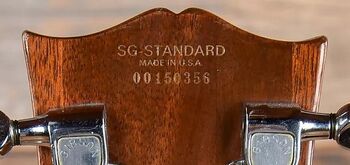
1976
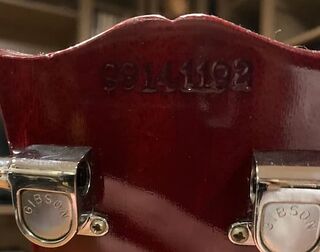
1975 stamped w/ prefix, no "Made in USA" or model name
In the few years approaching the change in serial system of 1977, the numbers became much more reliable for dating. While not all SGs produced from 1975–1977 used this system (many '75 models use the old system, suggesting it was implemented later in the year), all that did were produced in these years. Typically (but not always), serials from this era have the model name printed or stamped at the top, "Made in U.S.A." under that and the serial below. This was all printed onto a single oval-shaped decal. However, sometimes serial numbers using this numerical format would simply be stamped into the headstock with no model name above and "Made in U.S.A." placed below, as in previous years, or omitted entirely.
Note: It's not uncommon for the model name part of the decal to be clipped off and the production numbers be out of the expected range. This would happen if they ran out of decals for that model and simply used one from another model.
| Prefix | Year |
| 99XXXXXX | 1975 |
| 00XXXXXX | 1976 |
| 06XXXXXX | 1977 |
For 1976, the six-digit production numbers ranged as follows:
144,400–145,300 = SG Custom
148,800–153,200 = SG Standard
1977–2014[]
Gibson's then most sustainable numbering system was launched in August 1977, with a stamped-in 8-digit number. The 1st and 5th digit represent the year of manufacture. The 3 digits in-between denote the day of that year, while digits 6 to 8 give the production number.
1977–2005[]
YDDDYPPP
Y = Year
D = Day
P = Production Number
For example:
03262834 = 2002 | 326th day | # 834
After the opening of the new factory in Nashville in 1983, the production numbers began to denote the production site. 001 to 499 appeared on the instruments built in Kalamazoo, and 500 to 999 on those built in Nashville. Even after the closing of the Kalamazoo factory in 1984, this practice continued until 1989 in Nashville.
1994[]
In 1994, to celebrate Gibson's Centennial Anniversary, they changed their serial number format to the following.
YYPPPPPP
Y = Year
P = Production Number
For example:
94262834 = 1994 | # 262,834
This can prove confusing, but remember that the second digit of any regular USA serial number cannot be higher than 3.
2005–2014[]
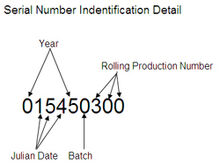
In July 2005, the system was changed to nine-digits, with a digit added at the beginning of the production number. The production numbers went from 500 to 699, after which the batch number 1 was included, and the production number returned to 500.
YDDDYBPPP
Y = Year
D = Day
B = Batch
P = Production Number
For example:
025494925 = 2009 | 254th day | Batch 4 | # 925
Starting in 2008, the model year was stamped under "Made in U.S.A." on the back of the headstock.
2013–2019[]
Gibson's most simplified system was introduced in late 2013 (Note: overlap occurred and some guitars used the old format until as late as July 2014). It remained a stamped 9-digit number, but the first 2 digits indicate the model year. This is not to be confused with the year in which it was actually produced. The lineup for every year has its production started in the fall or winter of the year before, so a guitar that was actually made in October of 2018 would be a model year 2019 example, and therefore the first two digits would be "19". The only way to know the actual production date of guitars made in this era is to have the original info card that came with the guitar.
The last 7 digits are a production number for all guitars produced that year. It also includes the model year stamped under "Made in USA", making decoding mostly redundant anyway.
YYPPPPPPP
Y = Model Year
P = Production Number
For example:
170604639 = 2017 model year | # 604,639
2019–Present[]
Some time around March 2019, Gibson dropped the year stamping and returned to the 2006–2013 format. However, the batches do not start at 500 anymore; they start at zero.
YDDDYBPPP
Y = Year
D = Day
B = Batch
P = Production Number
For example:
124690235 = 2019 | 246th day | Batch 0 | # 235
Custom Shop Serial Numbers[]
Historic Collection[]
2000-2019:
The Custom Shop uses a different format for Historic Collection SGs than it does for most other Historic Collection models, although it's shared with the Firebird and '68 Les Paul Reissue:
YYPPPM
Y = Year
P = Production Number
M = Model (1 = Special & Custom, 2 = Standard)
For example:
075292 = 2007 | # 529 | SG Standard
However, in 2010, the format changed so that the first digit was always zero, making it more difficult to distinguish a 2005 from a 2015. Because this leads to confusion, one way to differentiate a '00s model from a '10s (besides the changes in specs over the years) is to look at the Certificate of Authenticity; for most of the '00s, it was a single sheet of paper, whereas in the '10s, it was in a black booklet.
2000-2007:
2008-Present:
2020-Present:
In 2020, the format changed so that the first digit represents the year. Naturally, this means a serial can point to both 2010 and 2020 by starting with a zero. 2020 examples can be distinguished most easily by the double ring tuners introduced in 2018 on the Standard, or the Custom's switch to Grover Rotomatics in 2019. For the Special, the yellow case lining introduced in 2020 would be an indicator.
Y0PPPM
Y = Year
P = Production Number
M = Model (1 = Custom, 2 = Standard, 3 = Special & Junior)
For example:
105292 = 2021 | # 529 | SG Standard
Custom Collection[]
Special edition SGs and the EDS-1275 use the standard Custom Shop format:
(CS)YPPPP
In 2010, the production number increased to five digits.
Artist Signature Models[]
Gary Rossington SG: Two variations were used. Version 1 mimics 1961 ink-stamped format. Numbered in sequence as "1 3XXX". Version 2 uses standard Historic format explained above.
Tony Iommi SG: Numbered in sequence as "TI XXX"
Pete Townshend SG: Numbered in sequence as "PT XXX"
Robby Krieger SG: Numbered in sequence as either "Krieger XXX" or "RK XXX"
Earliest Known SGs[]
Prototype:[]
This is the model pictured in the 1962 catalog, showing a rectangular tenon cover, longer pickguard and blank TRC. One feature that differentiates this prototype from any production 1960 SG is the "Les Paul" script silk-screened on the headstock. Another is the pickguard actually touching the switch, which has no ring.
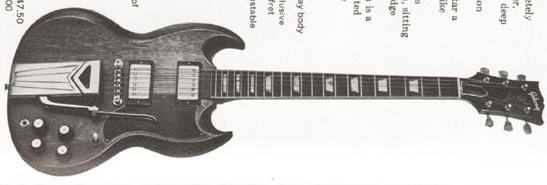
0 8765:[]
All original. Notice large tenon cover.
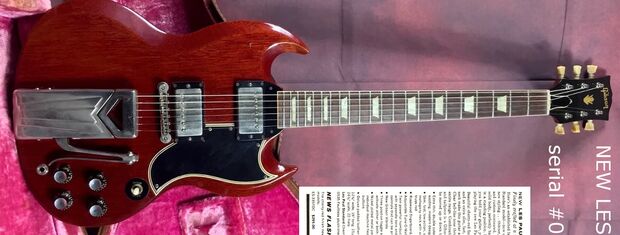
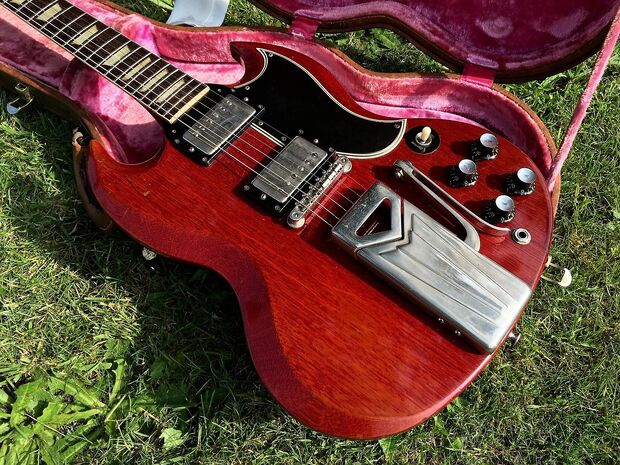
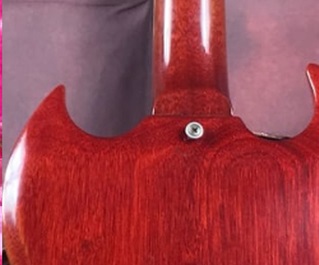
0 8869:[]
Truss rod cover was replaced with one from 1968 Les Paul. Also has large tenon cover like 0 8865.
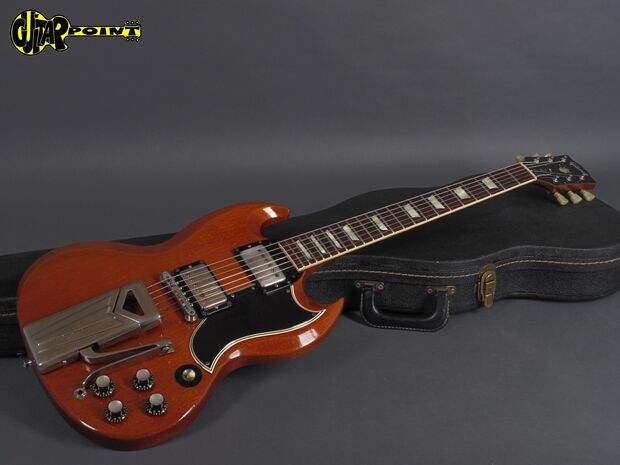
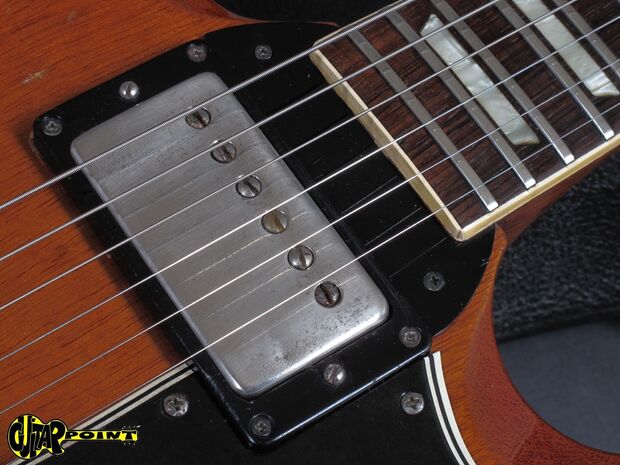
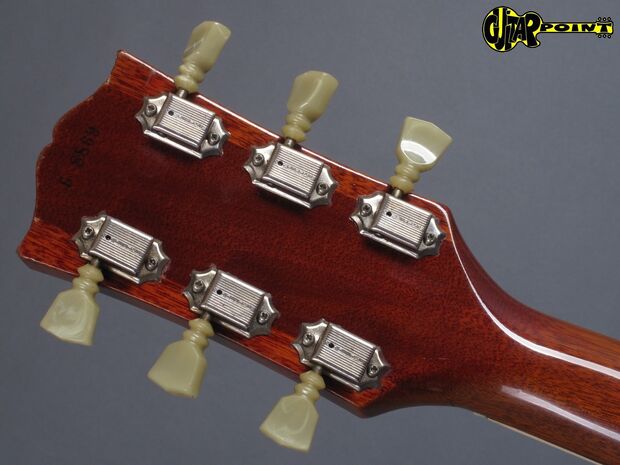
0 8875:[]
0 8877:[]
Most hardware replaced and stopbar installed, but original pickguard and tenon cover (now smaller).
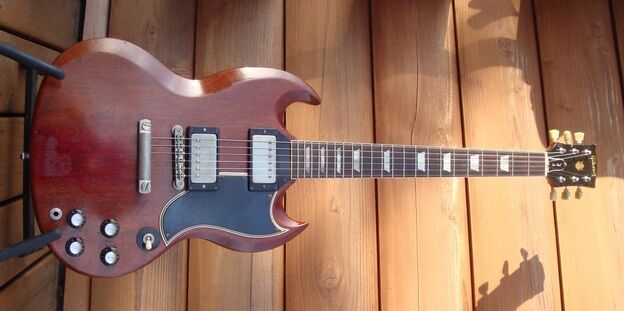
0 8878:[]
Rectangular tenon cover.
